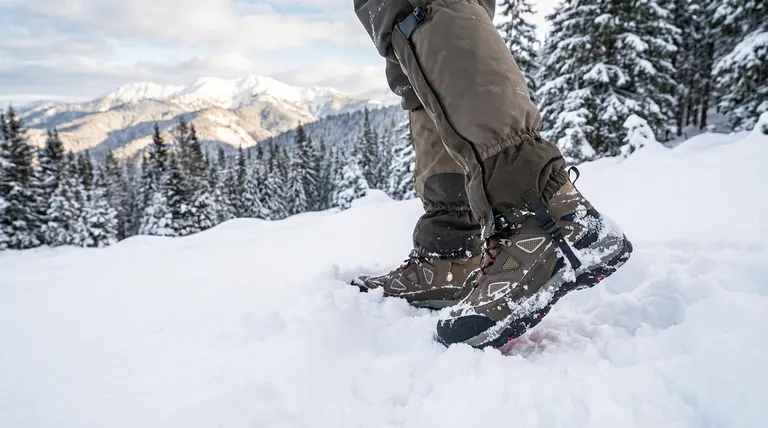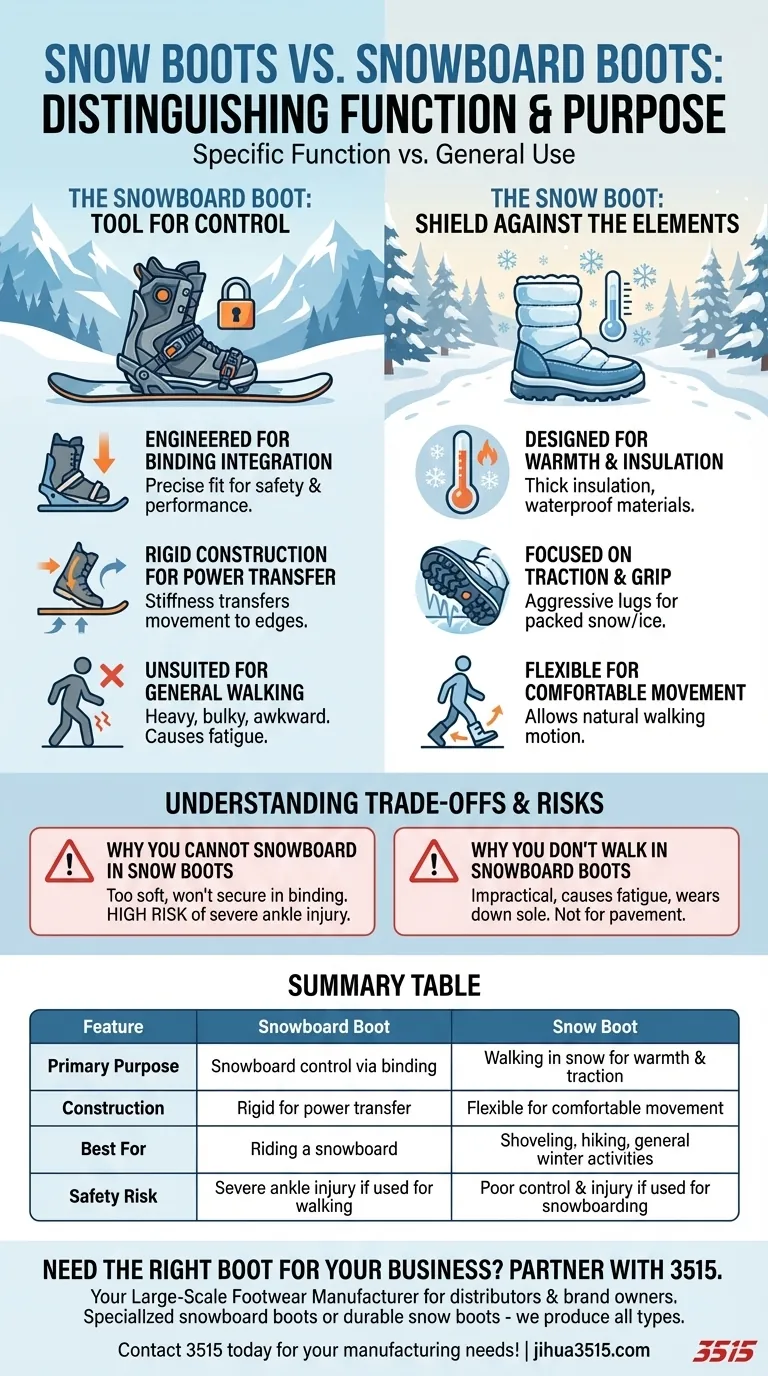The fundamental difference between a snow boot and a snowboard boot is one of specific function versus general use. Snowboard boots are a piece of specialized sporting equipment designed with a rigid structure to lock into a binding and control a snowboard. Snow boots are general-purpose winter footwear engineered for the sole purpose of keeping your feet warm, dry, and stable while walking in snow.
Choosing between them isn't about which is "better," but about which is the correct tool for the job. A snowboard boot is designed for integration with a binding for performance and safety, while a snow boot is designed for walking. Using one in place of the other is both ineffective and dangerous.

The Snowboard Boot: A Tool for Control
A snowboard boot is best understood as a piece of performance equipment, much like a ski boot. Its design prioritizes board control and rider safety over walking comfort.
Engineered for Binding Integration
The boot's shape, stiff materials, and overall footprint are precisely engineered to fit securely into a snowboard binding. This connection is critical for safety and performance.
Rigid Construction for Power Transfer
The defining feature of a snowboard boot is its stiffness. This rigidity is not for comfort; it exists to transfer the subtle movements from your legs and ankles directly to the edges of your snowboard, allowing you to turn, carve, and stop.
Unsuited for General Walking
This specialized, rigid construction makes snowboard boots heavy, bulky, and awkward for walking. Most riders change into more comfortable snow boots or shoes immediately after they are done riding for the day.
The Snow Boot: A Shield Against the Elements
A snow boot's mission is simple: to provide maximum protection from winter weather during general outdoor activities. Comfort and environmental protection are its primary design goals.
Designed for Warmth and Insulation
A snow boot’s core function is to keep your feet warm and dry in freezing, wet conditions. This is achieved through thick insulation and robust waterproof materials like rubber and treated synthetics.
Focused on Traction and Grip
The soles of snow boots feature deep, aggressive lugs designed to grip packed snow and ice. This focus on traction is a key safety feature that prevents slips and falls while walking.
Flexible for Comfortable Movement
Unlike a stiff snowboard boot, a good snow boot has a flexible upper and sole. This allows for a natural walking motion, making it comfortable for activities from shoveling the driveway to winter hiking.
Understanding the Trade-offs and Safety Risks
Confusing the purpose of these two boots can lead to significant problems, ranging from poor performance to serious injury.
Why You Cannot Snowboard in Snow Boots
This is the most critical takeaway. Regular snow boots are too soft and flexible to provide any meaningful control over a snowboard. They will not fit securely in a binding, creating a high risk of the boot pulling out and a near-certainty of severe ankle injury.
Why You Don't Walk Around in Snowboard Boots
While not a direct safety risk, using snowboard boots for general walking is highly impractical. Their weight and rigidity cause fatigue, and walking on pavement can wear down the sole, potentially compromising its fit within the binding over time.
Where Other Winter Boots Fit In
"Winter boots" are a broader category often designed for cold but less severe conditions, like walking on cleared city sidewalks. They may be warmer than a standard shoe but typically lack the deep traction and tall, waterproof construction of a true snow boot.
Making the Right Choice for Your Activity
Your choice of footwear should always be dictated by your specific goal.
- If your primary focus is snowboarding: You must use dedicated snowboard boots that are properly fitted to both your feet and your bindings for safety and control.
- If your primary focus is walking, playing, or working in deep snow: A high-quality, insulated, and waterproof snow boot is the correct choice for warmth and traction.
- If your primary focus is navigating cold but generally clear urban environments: A less bulky winter boot may offer a better balance of warmth, comfort, and style.
Ultimately, respecting the specialized design of each boot ensures you have the right protection and performance for your chosen winter activity.
Summary Table:
| Feature | Snowboard Boot | Snow Boot |
|---|---|---|
| Primary Purpose | Snowboard control via binding | Walking in snow for warmth & traction |
| Construction | Rigid for power transfer | Flexible for comfortable movement |
| Best For | Riding a snowboard | Shoveling, hiking, general winter activities |
| Safety Risk | Severe ankle injury if used for walking | Poor control & injury if used for snowboarding |
Need the Right Boot for Your Business? Partner with 3515, Your Large-Scale Footwear Manufacturer.
As a leading manufacturer, 3515 produces a comprehensive range of footwear for distributors, brand owners, and bulk clients. Whether you need specialized snowboard boots for performance or durable snow boots for warmth and traction, our production capabilities encompass all types of shoes and boots.
Let us help you provide your customers with the correct, high-quality footwear for their winter activities. Contact 3515 today to discuss your manufacturing needs!
Visual Guide

Related Products
- Safety Footwear Wholesale Manufacturer for Custom OEM/ODM Production
- Wholesale High-Traction Camo Boots - Custom Manufacturer for Brands
- Wholesale Safety Footwear Manufacturer for Bulk & Custom OEM Orders
- Factory-Direct Wholesale Canvas Boots with High-Traction Rubber Soles
- Factory Direct Wholesale Rain Boots Durable Waterproof & Fully Customizable
People Also Ask
- Is safety-toe as good as steel toe? Choose the Right Protection for Your Job
- What are OSHA approved shoes? Understanding the Correct Standards for Workplace Safety
- Is it normal to wear shoes in the house? A Guide to Hygiene, Comfort & Culture
- What are the cultural perspectives on wearing shoes in the house? A Guide to Home Etiquette & Hygiene
- How long can you wear safety boots? The Lifespan is Determined by Wear, Not Time



















